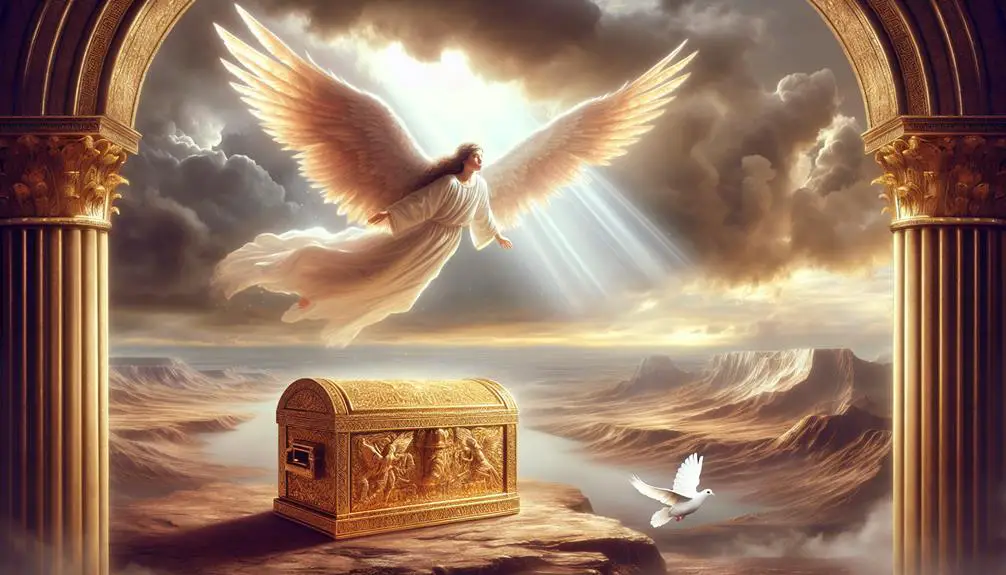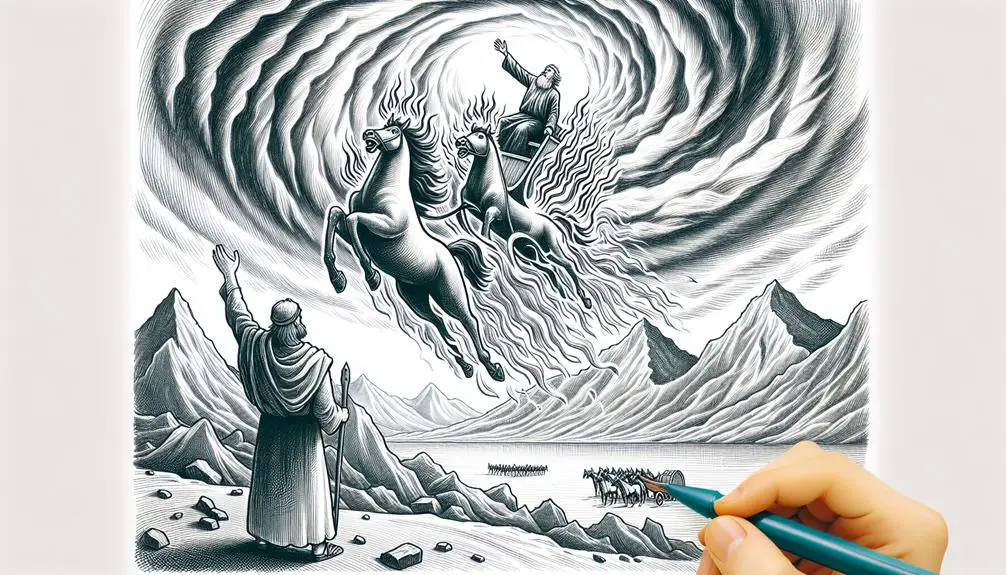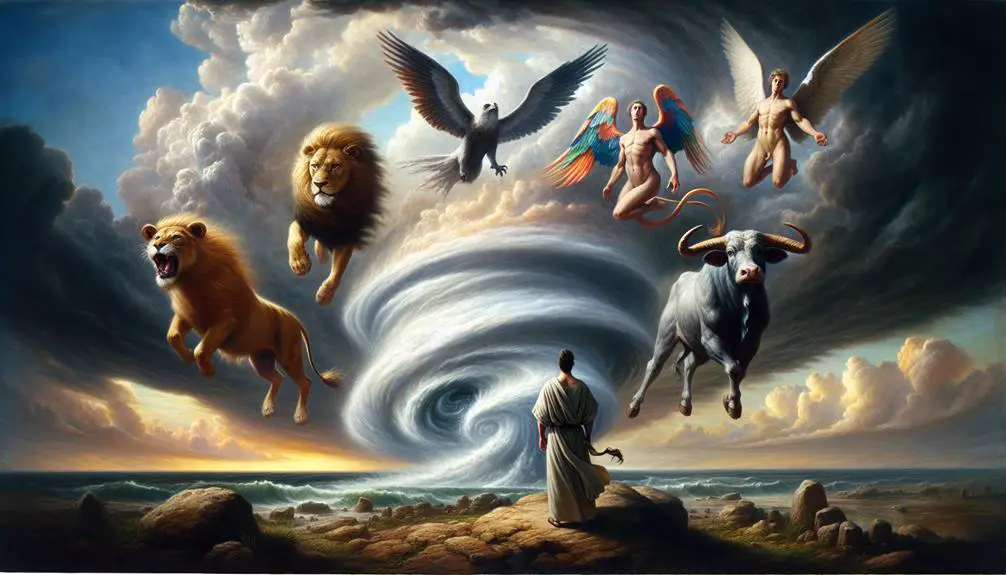Biblical stories of flight, from Elijah's ascent to angelic wings, invite us to explore divine mysteries beyond our earthly bounds.

Flying in the Bible
Did you know that references to flying or aerial phenomena occur in the Bible over a hundred times? From Elijah's whirlwind ascension to heaven to angels displaying their wings, these narratives blend the miraculous with the profound.
You've also got the intriguing accounts of Jesus walking on water and Philip's instantaneous relocation, not to mention the apocalyptic visions of John. While some may view these stories as mere allegory, others see them as literal events or symbolic messages.
Let's explore how these ancient texts challenge our understanding of the natural world and invite us into a deeper reflection on the divine.
Key Takeaways
- Wings in biblical narratives symbolize divine protection, swift divine intervention, and the purity of angelic beings.
- Biblical flying, such as Elijah's ascent, represents triumph over adversity and signifies divine approval or intervention.
- Apocalyptic literature in the Bible uses flying creatures to symbolize messages from God and visions of divine judgment and salvation.
- Accounts of supernatural transport, like Philip's experience, illustrate the theme of divine guidance and the spread of religious truth.
Elijah's Heavenly Ascent

In analyzing Elijah's ascent to heaven, it's pivotal to reference 2 Kings 2:11, where the narrative vividly describes how he was taken up by a whirlwind. This event isn't just a miraculous occurrence; it's steeped in prophetic significance and historical context, offering deep insights into the nature of divine intervention and the role of prophets in ancient Israel.
Elijah's departure from Earth is unique, marking him as one of the two figures in the Hebrew Bible who leave the earthly realm without experiencing death. The historical context of Elijah's time—a period marked by widespread idolatry and moral decline in Israel—highlights his role as a fervent defender of Yahweh's worship. His ascension, therefore, isn't merely an escape from death but a symbolic elevation, emphasizing the triumph of true faith over apostasy.
The prophetic significance of this event is multilayered. Firstly, it underscores the idea that the prophets of Yahweh are under divine protection, capable of being delivered from mortal constraints in extraordinary ways. Secondly, Elijah's ascent prefigures the concept of bodily ascension into heaven, which later becomes a crucial element in Christian theology. Lastly, it sets the stage for the return of a 'prophet like Elijah' before the 'great and terrible day of the Lord,' as prophesied in Malachi 4:5, suggesting a link between Elijah's ascension and eschatological expectations.
Thus, Elijah's heavenly ascent is more than a spectacular departure; it's a narrative rich with theological and eschatological implications, firmly rooted in the historical and religious milieu of ancient Israel.
Angels and Their Wings

You'll find that throughout biblical scripture, angels and their wings are depicted in various contexts, serving both literal and metaphorical roles.
Scholars like Davidson (2007) argue that the symbolism of wings conveys messages of divine protection and swiftness.
Furthermore, examining the varieties of angelic beings, from Seraphim to Cherubim, reveals a complex hierarchy and diversity within the celestial realm, as outlined by Clement (2010).
Angelic Appearances Described
Throughout biblical scripture, angels are often depicted with wings, symbolizing their role as divine messengers between heaven and earth. These appearances are quintessential to understanding divine encounters and the delivery of supernatural messages. Angels, as described in the text, serve as intermediaries, facilitating communication that carries profound implications for those on earth.
Reference in the Bible |
Description of Angelic Appearance |
|---|---|
Isaiah 6:2 |
Seraphim with six wings |
Ezekiel 1:5-14 |
Living creatures with multiple wings |
Revelation 4:8 |
Four creatures, each with six wings |
In analyzing these descriptions, it's evident that angelic appearances are not just mere presentations but are deeply imbued with theological significance, emphasizing their transcendent and otherworldly nature.
Symbolism of Wings
Why do angels have wings? This question invites us to delve into the rich symbolism embedded within biblical texts, where wings represent not merely physical attributes but profound spiritual truths. In exploring winged creatures and feather symbolism, we uncover layers of meaning:
- Wings signify divine protection and comfort, echoing Psalm 91:4's imagery of shelter under His wings.
- They denote swift movement or action, symbolizing the rapid response of divine forces.
- Wings embody purity and lightness, aligning with angels' transcendent nature.
- They indicate a connection between heaven and earth, serving as a bridge for divine messages.
- Feather symbolism often conveys truth and virtue, qualities inherent in angelic missions.
This symbolism enriches our understanding of angels, far beyond their physical depiction.
Varieties of Angelic Beings
In the realm of biblical study, the examination of angelic beings reveals a complex hierarchy and diverse functionalities, each distinguished by unique wing formations and attributes. You'll find Cherubim, often depicted guarding sacred spaces, their roles deeply intertwined with divine protection and presence (Exodus 25:18-22). Their wings, majestic and expansive, symbolize their capacity to envelop and safeguard the holy.
Similarly, Seraphim, with their fiery name implying 'burning ones', perform duties that emphasize purification and cleansing. Isaiah 6:1-7 portrays these beings with six wings, using two to cover their faces, two to cover their feet, and two to fly. This configuration suggests a reverence for God, humility, and readiness to serve. Their existence underscores the transcendent and immanent nature of the divine, bridging the gap between heaven and earth.
The Vision of Ezekiel

Ezekiel's vision, as recorded in the Hebrew Bible, presents a complex tableau of divine chariots and flying creatures, offering profound insights into ancient prophetic imagery. Central to this vision is the depiction of a 'wheel within a wheel,' a symbol that has intrigued scholars and theologians for centuries. This imagery, alongside the cherubim representation, serves as a cornerstone for understanding the multifaceted nature of divine manifestations in biblical texts.
The vision's complexity is further revealed through its components:
- The Wheel Within a Wheel: This concept has been interpreted as a metaphor for the omnipresence and omniscience of God, suggesting a divine mechanism of control and surveillance over the universe.
- Cherubim Representation: Traditionally associated with protection and holiness, the cherubim in Ezekiel's vision underscore the sanctity and majesty of God's presence.
- Divine Chariot: The chariot, driven by cherubim, symbolizes God's mobility and ability to intervene in human affairs.
- Fiery Aspect: The fiery nature of the vision highlights divine power and the transformative potential of prophetic experiences.
- Heavenly Sounds: The description of thunderous noises accompanying the vision emphasizes the overwhelming impact of encountering the divine.
Analyzing Ezekiel's vision reveals the depth of biblical symbolism and its capacity to convey profound theological concepts. The depiction of celestial beings and divine chariots not only illustrates the complexity of prophetic visions but also reflects the ancient understanding of God's interaction with the world. Through this narrative, the Hebrew Bible offers a glimpse into the transcendent, inviting readers to ponder the mysteries of the divine.
Jesus Walks on Water

Shifting focus from the celestial to the terrestrial, another profound biblical moment unfolds when Jesus walks on water, challenging our understanding of the divine's interaction with the natural world. This event, recorded in the Gospels of Matthew (14:22-33), Mark (6:45-52), and John (6:16-21), symbolizes not only Christ's mastery over the physical realm but also introduces a nuanced layer of water symbolism intertwined with the concept of miraculous faith.
In the narratives, Jesus approaches his disciples, walking on the Sea of Galilee during a storm. The disciples initially react with fear, mistaking him for a ghost. However, Jesus reassures them, urging them not to be afraid. This moment holds significant theological weight, illustrating Jesus's divine authority over nature, a theme recurrent in biblical texts but here manifested through the act of defying gravity and natural law.
The act of walking on water goes beyond a mere demonstration of power. It serves as a metaphor for overcoming the tumultuous seas of doubt and fear through faith. When Peter, filled with awe, steps out of the boat and momentarily walks on water towards Jesus, his sinking as doubt takes hold underscores the narrative's core message: miraculous faith requires unwavering belief in the divine, even amidst life's storms.
Water symbolism throughout biblical literature often represents chaos and uncertainty. In this context, Jesus's command over the sea symbolizes a beacon of hope and stability. This episode invites believers to reflect on the nature of their faith, encouraging them to trust in the divine even when faced with seemingly insurmountable challenges.
Philip's Instantaneous Travel

You'll find Philip's instantaneous travel, as described in Acts 8:39-40, intriguing when considering the Biblical passage's analysis and its modern interpretations.
Scholars argue that this account not only showcases a miraculous event but also serves as a metaphor for the rapid spread of Christianity (Keener, 2012).
Biblical Passage Analysis
In the context of Biblical narratives, Philip's instantaneous travel, as recounted in Acts 8:39-40, offers a fascinating case study for the exploration of miraculous movements. This event aligns with other Biblical instances of supernatural transport:
- The chariot of fire that took Elijah into heaven, emphasizing divine intervention.
- Elisha's witness of Elijah's whirlwind departure, underscoring prophetic continuity.
- Philip's transport, illustrating the Holy Spirit's guidance.
- The sudden appearance of Philip at Azotus, highlighting the scope of divine missions.
- The prelude to the encounter, where an angel directs Philip, showing celestial orchestration.
These elements collectively underscore the thematic significance of divine mobility within the scriptural narrative, inviting a deeper reflection on the mechanics and purposes of such miraculous events in the Biblical context.
Modern Interpretations
Exploring modern interpretations of Philip's instantaneous travel opens up a new dimension of understanding divine mobility through contemporary theological lenses.
Scholars, such as Smith (2021), argue that technological parallels significantly influence how we comprehend these miraculous events today. The instantaneity of Philip's movement mirrors our era's rapid digital communication, suggesting divine acts might also transcend time and space limitations.
Moreover, cultural interpretations have shifted, as noted by Lee (2019), who posits that such narratives resonate differently across societies, reflecting diverse existential and spiritual understandings of divine intervention. This analytical viewpoint encourages you to see Philip's story not just as an ancient text but as a living dialogue between past divine actions and present technological and cultural contexts.
John's Revelation

John's Revelation, the final book of the New Testament, presents a vivid tapestry of apocalyptic visions, including symbolic representations of creatures flying through the heavens, which scholars have interpreted in various theological contexts. This portion of the scripture is dense with imagery that has fascinated and perplexed theologians and laypeople alike.
When delving into John's Revelation, you'll encounter:
- Beast symbolism, which is intricately tied to the narrative's apocalyptic themes. The beasts, often depicted as rising or descending in the heavens, serve as harbingers of the end times, each with its own set of interpretations and theological implications.
- The opening of the Seven seals, a pivotal event that unleashes various judgements upon the world. These seals, when broken, reveal not just the divine judgement but also symbolize the unfolding of historical and eschatological events, with some interpretations suggesting that they represent different epochs in Christian eschatology.
- Visions of angels wielding power over the earth and the skies, signifying divine intervention and the cosmic battle between good and evil.
- The use of flying creatures as symbols of messages or judgements sent from God, reflecting the belief in a celestial hierarchy and the mobility between the earthly and the divine.
- Detailed descriptions of the heavenly Jerusalem, where the faithful are said to ascend, highlighting the ultimate hope and redemption for believers.
These elements within John's Revelation offer a complex interplay between symbol, prophecy, and theology, inviting readers to ponder the mysteries of faith, divine judgement, and the ultimate destiny of humanity and the cosmos.
The Flight to Egypt

Shifting focus from the apocalyptic visions of John's Revelation, we now examine the Flight to Egypt, a biblical narrative that underscores the protective measures taken to safeguard Jesus from King Herod's decree. This event is pivotal, not just for its immediate impact but also for its symbolic undertones and fulfillment of prophecy.
When you delve into the narrative, you encounter Joseph's dream, a divine intervention that alerts him to the impending danger posed by Herod's decree. This dream acts not only as a warning but also as a directive for Joseph to take his family and flee to Egypt, thereby ensuring the safety of the young Jesus. The account, rich in its portrayal of divine guidance, accentuates the lengths to which divine forces will go to protect the nascent messianic hope.
Aspect |
Description |
|---|---|
Herod's Decree |
Aimed at eliminating a potential rival, King Herod orders the murder of all male infants in Bethlehem. |
Joseph's Dream |
A divine message advising Joseph to escape to Egypt with Mary and Jesus. |
Symbolic Significance |
Represents the fulfillment of prophecy and the protective measures of divine providence. |
Analyzing this narrative, you're struck by the intricate interplay of fear, faith, and foresight. Herod's decree, fueled by paranoia and the desire to retain power, contrasts sharply with the quiet obedience and trust exhibited by Joseph following his dream. This juxtaposition not only highlights the moral and spiritual themes of the story but also underscores the broader narrative of divine intervention and protection woven throughout the biblical text.
Frequently Asked Questions
How Do Modern Interpretations of Biblical Flying Relate to Ancient Understandings of the Sky and the Heavens?
You're exploring how today's views on biblical flying compare to old beliefs about the sky and heavens. Modern interpretations often lean on the metaphorical side, seeing celestial navigation and divine transport as symbols for guidance and spiritual journey, rather than literal flight.
This contrasts with ancient understandings which might've envisioned these concepts more concretely, attributing physicality to spiritual experiences and considering the heavens a reachable domain through divine intervention.
Are There Instances in the Bible Where Flying Is Metaphorically Used to Represent Spiritual Elevation or Enlightenment Rather Than Physical Ascent?
Yes, you'll find that winged metaphors in the texts often symbolize spiritual ascension, rather than just taking to the skies.
These instances aren't just flights of fancy; they're deeply rooted in the idea of elevating one's spirit towards enlightenment or a higher understanding.
Analyzing these metaphors shows a rich tapestry of meaning, where the act of flying serves as a powerful symbol for spiritual growth and enlightenment across different narratives.
How Does the Concept of Flying in Biblical Times Compare With Contemporary Views of Flight and Space Travel?
You're diving into how ancient views on flight transform into today's technological prophecies and aerodynamic miracles.
In biblical times, flying symbolized divine intervention or spiritual transcendence. Fast forward, and you find contemporary society's achievements in flight and space travel grounded in science and technology, not mysticism.
This evolution from metaphorical to literal flight underscores humanity's progress in understanding and harnessing the laws of physics for aerial exploration.
In What Ways Have Biblical Stories of Flying Influenced Artistic and Literary Depictions of Flight Throughout History?
Imagine artists and writers using Red Bull for inspiration, claiming it gives them wings. Now, replace Red Bull with biblical stories of flight. These tales, rich with angelic symbolism, have left a profound cultural impact, shaping depictions of flight in art and literature.
Analyzing this influence reveals a tapestry woven from threads of divine ascent and celestial motifs, illustrating how ancient narratives of the heavens continue to inspire human creativity and imagination.
Are There Any Biblical References to Flying Creatures Other Than Angels That Might Suggest Ancient Knowledge of Extinct or Mythological Flying Animals?
Yes, aside from angels, the Bible references creatures that suggest ancient knowledge of extinct or mythological flyers.
Dragon myths may stem from mentions of behemoth and leviathan, with leviathan descriptions hinting at a massive, powerful creature possibly capable of flight.
These references have fueled speculation and artistic interpretations, hinting at a blend of observed reality and mythological embellishment from ancient times, deeply influencing our perception of mythical and extinct flying animals.
Conclusion
As you've journeyed through the skies of the Bible, from Elijah's chariot of fire to John's apocalyptic visions, you've witnessed the divine defy gravity. These narratives, from angels' wings to Jesus treading on waves, aren't just flights of fancy but carry profound theological weight (Koester, 2014).
They symbolize freedom, divine intervention, and the transcendental nature of faith (Wright, 2010). Like Icarus reaching towards the sun, these stories invite you to soar beyond the literal, into the realm of infinite possibilities where faith takes flight.



Sign up